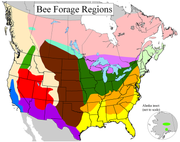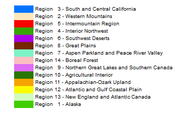This is a great reference of what blooms in your region, provided by NASA Goddard Space Flight Center and chapter 11 of The Hive and the Honey Bee ( BEE FORAGE OF NORTH AMERICA AND THE POTENTIAL FOR PLANTING FOR BEES). The information includes the United States and Great Lakes Regions and southern Canada. This map is by region and includes bushes, grasses, plants, shrubs and trees.
HONEY BEE FORAGE MAP NASA GODDARD SPACE FLIGHT CENTERThe 14 regions of the Ayers and Harman honey bee forage map are indicated below. These regions are based on natural patterns of land use and flora. Note that selecting the large pink area in the northern boreal region of the Canadian provinces will not provide a list of species at this time. Ayers and Harman indicated that this is not an important beekeeping region. Forage is similar to that of Alaska and is characterized by long harsh winters and a short forage season. Other sources of forage information exist for the region and we will attempt to provide that information as soon as we are able.
(GO TO THE ABOVE LINK, BELOW IS JUST A VISUAL)
Click on the map to see a list of honey bee forage species and their blooming periods for any region within a state. "This map, and the associated species lists that are provided via this map, are based on a map and table produced by George S. Ayers and Jay R. Harman, both of Michigan State University, and provided in Chapter 11 (Bee Forage of North America and the Potential for Planting for Bees) of the book The Hive and the Honey Bee, 1992, Graham, J. ed. Dadant and Sons Inc. Hamilton, Illinois."[/i]
"This map, and the associated species lists that are provided via this map, are based on a map and table produced by George S. Ayers and Jay R. Harman, both of Michigan State University, and provided in Chapter 11 (Bee Forage of North America and the Potential for Planting for Bees) of the book The Hive and the Honey Bee, 1992, Graham, J. ed. Dadant and Sons Inc. Hamilton, Illinois."[/i]
